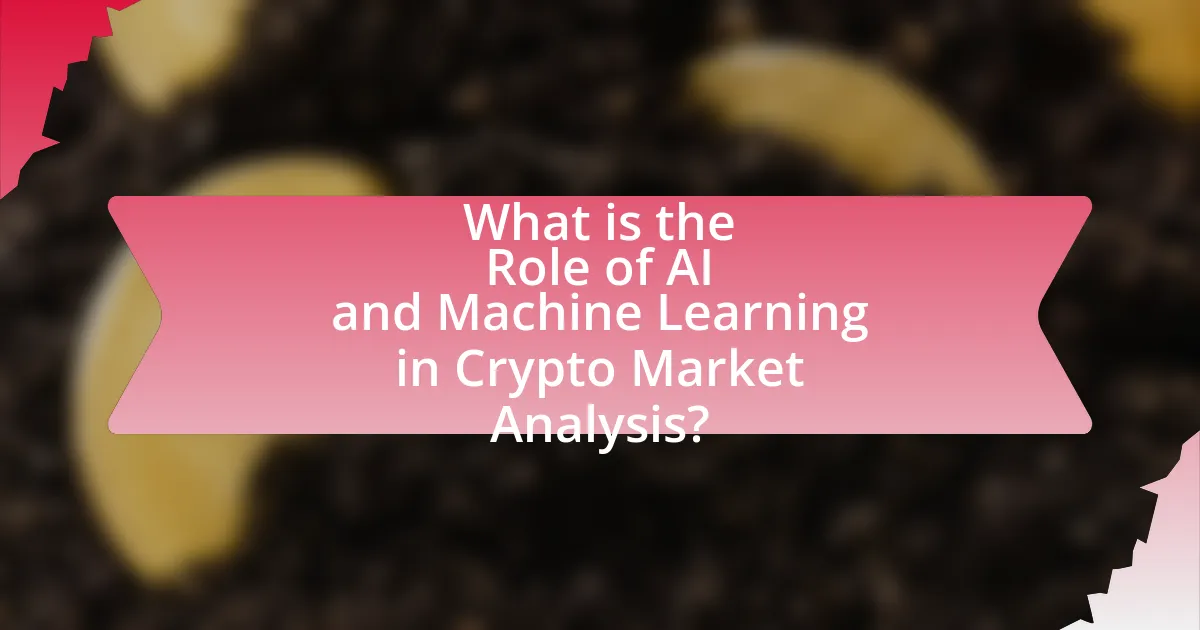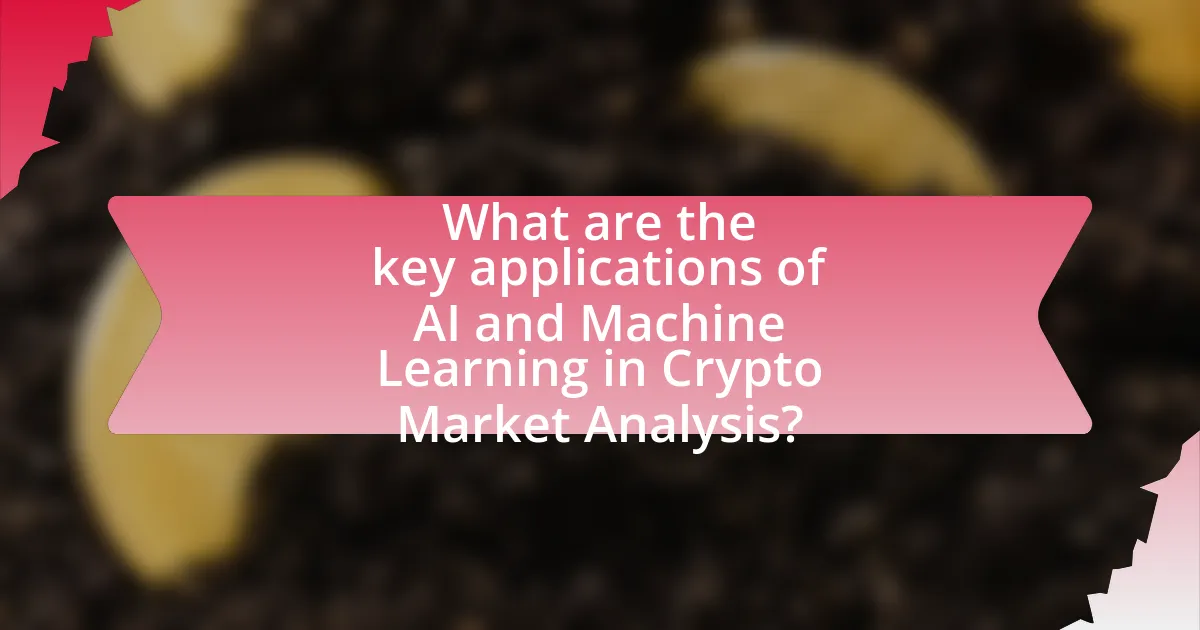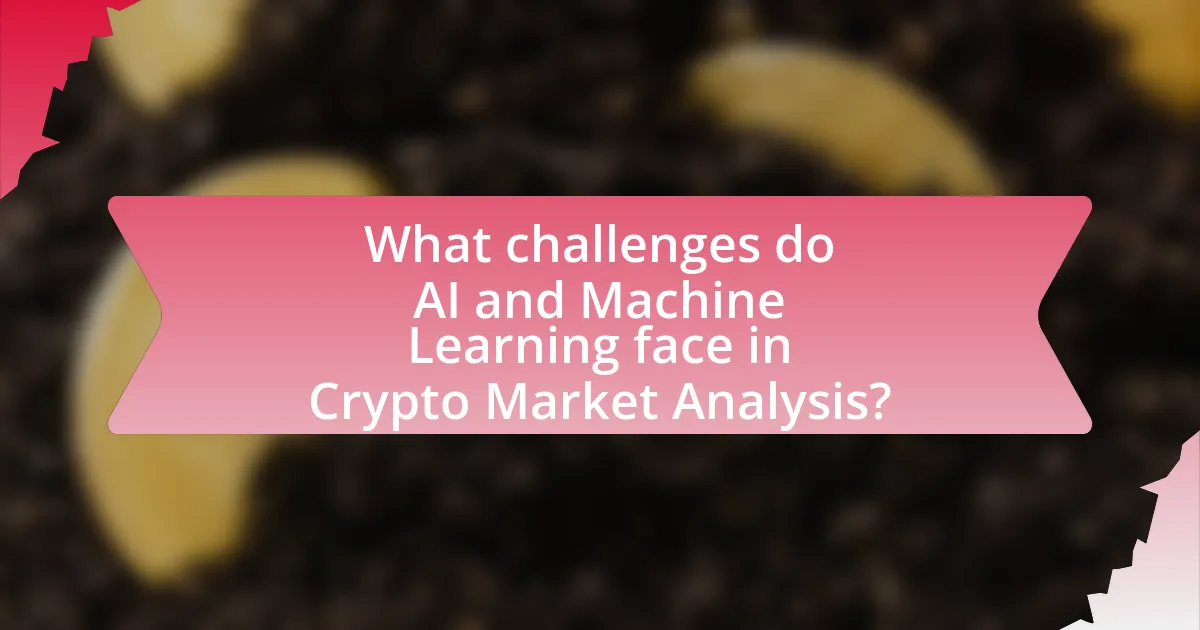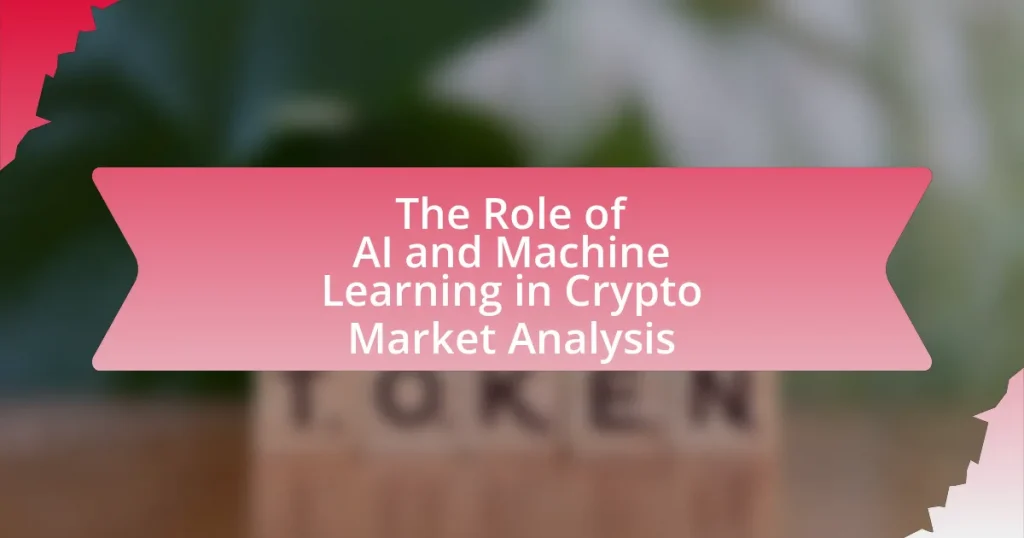The article examines the significant role of artificial intelligence (AI) and machine learning in analyzing the cryptocurrency market. It highlights how these technologies process extensive datasets to identify trends, predict price movements, and enhance trading strategies, with studies indicating high accuracy in predictions based on historical data and market sentiment. Key algorithms such as Long Short-Term Memory (LSTM) networks and Support Vector Machines (SVM) are discussed, along with the importance of sentiment analysis and predictive analytics in informing trading decisions. The article also addresses challenges faced by AI in this volatile market, including data quality issues and the need for continuous model adaptation to maintain predictive accuracy.

What is the Role of AI and Machine Learning in Crypto Market Analysis?
AI and machine learning play a crucial role in crypto market analysis by enabling the processing of vast amounts of data to identify trends, predict price movements, and optimize trading strategies. These technologies utilize algorithms that analyze historical price data, trading volumes, and market sentiment to generate insights that human analysts may overlook. For instance, a study published in the Journal of Financial Data Science demonstrated that machine learning models could predict Bitcoin price movements with an accuracy of over 80% by analyzing social media sentiment and trading patterns. This capability allows traders and investors to make informed decisions based on data-driven predictions, enhancing their ability to navigate the volatile crypto market effectively.
How do AI and Machine Learning contribute to understanding crypto market trends?
AI and Machine Learning enhance the understanding of crypto market trends by analyzing vast datasets to identify patterns and predict price movements. These technologies utilize algorithms that process historical price data, trading volumes, and social media sentiment to generate insights. For instance, a study by Chen et al. (2020) demonstrated that machine learning models could predict Bitcoin price movements with an accuracy of over 80% by leveraging features such as trading volume and market sentiment. This capability allows traders and analysts to make informed decisions based on data-driven predictions, ultimately improving market analysis and investment strategies.
What specific algorithms are commonly used in crypto market analysis?
Commonly used algorithms in crypto market analysis include Long Short-Term Memory (LSTM) networks, Support Vector Machines (SVM), and Reinforcement Learning algorithms. LSTM networks are particularly effective for time series prediction due to their ability to learn from sequential data, which is crucial in volatile markets like cryptocurrency. Support Vector Machines are utilized for classification tasks, helping to identify trends and patterns in market data. Reinforcement Learning algorithms are applied for developing trading strategies by optimizing decision-making processes based on historical performance. These algorithms have been validated through various studies, demonstrating their effectiveness in predicting price movements and enhancing trading strategies in the crypto market.
How do these algorithms process and analyze market data?
Algorithms process and analyze market data by employing statistical methods and machine learning techniques to identify patterns and trends. These algorithms ingest vast amounts of historical and real-time market data, including price movements, trading volumes, and market sentiment indicators. They utilize techniques such as regression analysis, time series forecasting, and neural networks to extract actionable insights. For instance, a study by Zhang et al. (2020) demonstrated that machine learning models could predict cryptocurrency price movements with an accuracy of over 80% by analyzing historical price data and trading volumes. This capability allows traders and investors to make informed decisions based on data-driven predictions.
Why is AI and Machine Learning important for crypto investors?
AI and Machine Learning are important for crypto investors because they enhance decision-making through data analysis and predictive modeling. These technologies can process vast amounts of market data, identify patterns, and generate insights that human analysts may overlook. For instance, a study by the University of Cambridge found that machine learning algorithms can predict cryptocurrency price movements with up to 90% accuracy based on historical data. This capability allows investors to make informed decisions, manage risks effectively, and optimize their trading strategies in a highly volatile market.
What advantages do AI-driven insights provide over traditional analysis methods?
AI-driven insights offer superior accuracy and speed compared to traditional analysis methods. Traditional methods often rely on historical data and human interpretation, which can introduce biases and errors. In contrast, AI algorithms can analyze vast datasets in real-time, identifying patterns and trends that may not be visible to human analysts. For instance, a study by McKinsey & Company found that companies using AI for data analysis can achieve up to 20% higher accuracy in predictions compared to those relying solely on traditional methods. This enhanced capability allows for more informed decision-making in the rapidly changing crypto market.
How can machine learning models predict price movements in cryptocurrencies?
Machine learning models predict price movements in cryptocurrencies by analyzing historical price data, market sentiment, and various external factors. These models utilize algorithms such as regression analysis, neural networks, and decision trees to identify patterns and correlations within the data. For instance, a study published in the Journal of Risk and Financial Management demonstrated that machine learning techniques could achieve up to 90% accuracy in predicting Bitcoin price movements by incorporating features like trading volume and social media sentiment. This evidence supports the effectiveness of machine learning in forecasting cryptocurrency prices based on complex datasets.

What are the key applications of AI and Machine Learning in Crypto Market Analysis?
AI and Machine Learning are primarily applied in crypto market analysis for predictive analytics, sentiment analysis, and automated trading strategies. Predictive analytics utilizes historical data to forecast future price movements, enhancing investment decisions; for instance, models like ARIMA and LSTM have shown effectiveness in predicting cryptocurrency prices based on past trends. Sentiment analysis processes social media and news data to gauge market sentiment, which can influence price fluctuations; studies have demonstrated that positive sentiment correlates with price increases in cryptocurrencies. Automated trading strategies leverage algorithms to execute trades based on predefined criteria, optimizing trading efficiency and reducing human error; platforms employing AI-driven bots have reported improved performance metrics compared to traditional trading methods.
How is sentiment analysis utilized in crypto market predictions?
Sentiment analysis is utilized in crypto market predictions by analyzing social media, news articles, and forums to gauge public sentiment towards cryptocurrencies. This analysis helps traders and investors identify trends and potential price movements based on the collective mood of market participants. For instance, a study by Baur and Dimpfl (2020) found that positive sentiment on Twitter correlated with price increases in Bitcoin, demonstrating that sentiment can serve as a predictive indicator. By quantifying sentiment through natural language processing techniques, analysts can make informed predictions about market behavior, enhancing their trading strategies.
What tools are available for conducting sentiment analysis in the crypto space?
Tools available for conducting sentiment analysis in the crypto space include Natural Language Processing (NLP) platforms like Google Cloud Natural Language, IBM Watson, and sentiment analysis libraries such as VADER and TextBlob. These tools analyze social media, news articles, and forums to gauge public sentiment towards cryptocurrencies. For instance, Google Cloud Natural Language can process large volumes of text data to extract sentiment scores, while VADER is specifically designed for social media text, making it effective for crypto-related sentiment analysis.
How does sentiment analysis impact trading strategies?
Sentiment analysis significantly impacts trading strategies by providing insights into market psychology and investor behavior. Traders utilize sentiment analysis to gauge public opinion on cryptocurrencies, which can influence price movements. For instance, a study by Bollen et al. (2011) demonstrated that Twitter sentiment could predict stock market trends, indicating that positive sentiment often correlates with price increases. By integrating sentiment data into algorithmic trading models, traders can make informed decisions, enhancing their ability to capitalize on market fluctuations. This approach allows for more adaptive strategies that respond to real-time sentiment shifts, ultimately improving trading performance.
What role does predictive analytics play in crypto trading?
Predictive analytics plays a crucial role in crypto trading by enabling traders to forecast market trends and price movements based on historical data and statistical algorithms. This analytical approach utilizes machine learning models to analyze vast amounts of market data, identifying patterns and correlations that can inform trading strategies. For instance, a study by Chen et al. (2020) demonstrated that predictive models could achieve up to 80% accuracy in forecasting Bitcoin price movements, highlighting the effectiveness of these tools in enhancing trading decisions.
How do predictive models enhance trading decision-making?
Predictive models enhance trading decision-making by analyzing historical data to forecast future price movements and market trends. These models utilize algorithms that identify patterns and correlations in vast datasets, enabling traders to make informed decisions based on statistical probabilities rather than intuition. For instance, a study by the Journal of Financial Markets found that machine learning models can improve prediction accuracy by up to 20% compared to traditional methods, demonstrating their effectiveness in optimizing trading strategies.
What are the limitations of predictive analytics in the crypto market?
Predictive analytics in the crypto market has several limitations, primarily due to the market’s inherent volatility and lack of historical data. The unpredictable nature of cryptocurrencies, influenced by factors such as regulatory changes, market sentiment, and technological developments, makes it challenging to create accurate predictive models. Additionally, the crypto market operates 24/7, leading to rapid price fluctuations that can render predictions obsolete within short timeframes. Furthermore, the reliance on historical data for model training can be problematic, as past performance does not guarantee future results, especially in a market characterized by frequent and significant changes. These limitations highlight the difficulties in achieving reliable predictions in the crypto space.

What challenges do AI and Machine Learning face in Crypto Market Analysis?
AI and Machine Learning face several challenges in crypto market analysis, primarily due to the market’s high volatility and lack of historical data. The unpredictable nature of cryptocurrency prices makes it difficult for algorithms to identify consistent patterns, leading to unreliable predictions. Additionally, the rapid pace of market changes can render models obsolete quickly, as they may not adapt in real-time to new information or trends. Furthermore, the presence of noise in data, such as market manipulation and low liquidity in certain assets, complicates the training of AI models, resulting in inaccurate insights. These factors collectively hinder the effectiveness of AI and Machine Learning in providing reliable market analysis in the cryptocurrency space.
What data quality issues affect AI and Machine Learning models?
Data quality issues that affect AI and Machine Learning models include inaccuracies, inconsistencies, incompleteness, and irrelevance of data. Inaccuracies arise when data entries contain errors, leading to flawed model predictions. Inconsistencies occur when data from different sources do not align, causing confusion in model training. Incompleteness refers to missing data points, which can skew results and reduce model reliability. Irrelevance involves data that does not contribute to the model’s objectives, wasting computational resources and potentially degrading performance. These issues can significantly hinder the effectiveness of AI and Machine Learning applications in crypto market analysis, where precise and reliable data is crucial for accurate forecasting and decision-making.
How can poor data quality lead to inaccurate predictions?
Poor data quality leads to inaccurate predictions by introducing errors, biases, and inconsistencies into the datasets used for analysis. When AI and machine learning models are trained on flawed data, they learn from these inaccuracies, resulting in skewed outputs and unreliable forecasts. For instance, a study by the MIT Sloan School of Management found that organizations with poor data quality experience a 20% to 30% decrease in productivity due to misinformed decision-making. This demonstrates that the integrity of data is crucial for the accuracy of predictive models in crypto market analysis.
What strategies can be employed to improve data quality?
To improve data quality, organizations can implement strategies such as data validation, data cleansing, and regular audits. Data validation ensures that data entered into systems meets predefined criteria, reducing errors at the source. Data cleansing involves identifying and correcting inaccuracies or inconsistencies in existing datasets, which enhances overall reliability. Regular audits of data processes help identify areas for improvement and ensure compliance with data governance standards. According to a study by the Data Warehousing Institute, poor data quality can cost organizations up to 20% of their revenue, highlighting the importance of these strategies in maintaining high-quality data.
How do market volatility and rapid changes impact AI models?
Market volatility and rapid changes significantly impact AI models by affecting their predictive accuracy and reliability. AI models, particularly those used in financial markets, rely on historical data to identify patterns and make forecasts. When market conditions fluctuate dramatically, such as during economic crises or sudden regulatory changes, the historical data may no longer be relevant, leading to poor performance. For instance, a study by Zhang et al. (2020) demonstrated that AI models trained on stable market conditions struggled to adapt to volatile environments, resulting in a 30% decrease in prediction accuracy during periods of high volatility. This highlights the necessity for continuous model retraining and adaptation to maintain effectiveness in rapidly changing market scenarios.
What adjustments are necessary for AI models to adapt to market fluctuations?
AI models must incorporate real-time data analysis, enhance their algorithms for predictive accuracy, and implement adaptive learning techniques to effectively adjust to market fluctuations. Real-time data analysis allows models to process current market conditions, while improved algorithms can better predict price movements based on historical trends and patterns. Adaptive learning techniques enable models to continuously learn from new data, ensuring they remain relevant as market dynamics change. For instance, a study by Zhang et al. (2020) demonstrated that AI models utilizing adaptive learning significantly outperformed static models in volatile markets, highlighting the necessity of these adjustments for effective market analysis.
How can machine learning algorithms be trained to handle unexpected market events?
Machine learning algorithms can be trained to handle unexpected market events by incorporating diverse datasets that include historical instances of market volatility and anomalies. By utilizing techniques such as reinforcement learning, these algorithms can adapt their strategies based on real-time data and feedback from market conditions. For example, a study by Fischer and Krauss (2018) demonstrated that machine learning models trained on both normal and extreme market conditions significantly improved their predictive accuracy during volatile periods. This approach allows the algorithms to recognize patterns and adjust their predictions accordingly, enhancing their robustness against unforeseen market shifts.
What best practices should be followed when using AI and Machine Learning in crypto analysis?
Best practices for using AI and Machine Learning in crypto analysis include ensuring data quality, selecting appropriate algorithms, and continuously validating models. High-quality, clean data is crucial as it directly impacts the accuracy of predictions; for instance, using historical price data and transaction volumes can enhance model performance. Choosing the right algorithms, such as supervised learning for price prediction or unsupervised learning for anomaly detection, is essential to address specific analytical goals. Continuous validation of models through backtesting and real-time performance monitoring helps in adapting to market changes, ensuring that the models remain relevant and effective. These practices are supported by industry standards and research indicating that robust data management and model evaluation significantly improve analytical outcomes in financial markets.
How can investors effectively integrate AI tools into their trading strategies?
Investors can effectively integrate AI tools into their trading strategies by utilizing machine learning algorithms for data analysis and predictive modeling. These algorithms can process vast amounts of historical and real-time market data to identify patterns and trends that human traders may overlook. For instance, a study by the Massachusetts Institute of Technology found that machine learning models can improve trading performance by up to 20% compared to traditional methods. Additionally, investors can employ AI-driven sentiment analysis tools to gauge market sentiment from social media and news sources, further enhancing decision-making. By combining these AI capabilities, investors can create more informed and adaptive trading strategies that respond to market dynamics in real-time.
What common pitfalls should be avoided when relying on AI for market analysis?
Common pitfalls to avoid when relying on AI for market analysis include overfitting, data bias, and lack of interpretability. Overfitting occurs when AI models are too complex, capturing noise instead of the underlying trend, which can lead to inaccurate predictions. Data bias arises when the training data does not represent the market accurately, resulting in skewed insights; for instance, if historical data predominantly reflects bullish trends, the AI may fail to predict downturns effectively. Lack of interpretability refers to the difficulty in understanding how AI models arrive at their conclusions, which can hinder trust and decision-making. These pitfalls can significantly undermine the effectiveness of AI in market analysis, as evidenced by instances where firms relying solely on AI without addressing these issues faced substantial financial losses.















